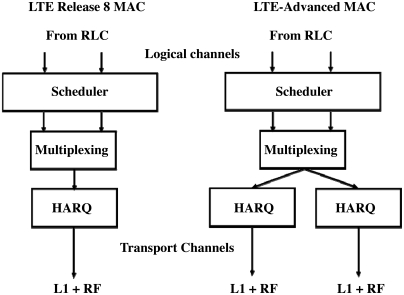4.3 Protocol Impact from Carrier Aggregation
In this section, we discuss the impact on the LTE protocol structure and key procedures such as mobility from carrier aggregation.
The use of carrier aggregation is purely internal to the eNodeB. 3GPP specifications assume both carriers belong to the same eNodeB. In the user plane protocol design, the use of carrier aggregation is not visible above the Medium Access Control (MAC) layer. The Radio Link Control layer provides the logical channels as in Release 8, and if the carrier aggregation is enabled, the MAC layer functionality will then split the data on multiple downlink carriers, often referred as Downlink Component Carriers (DCC) also. The MAC layer will notify the RLC layer about transmission opportunities considering all carriers so that RLC PDUs can be formed accordingly, which is facilitated by the co-located RLC and MAC functionalities in eNodeB as shown in Chapter 3. Each of the carriers has their own physical layer retransmission handling as shown in Figure 4.4. There are separate per carrier HARQ entities, all HARQ entities of a UE use the same C-RNTI for scheduling because there is a single RRC connection per UE.
Figure 4.4 MAC structure with carrier aggregation.

The scheduler functionality in the MAC layer will determine which of the component carriers should be used. This is done based on the carrier specific quality ...
Get LTE Advanced: 3GPP Solution for IMT-Advanced now with the O’Reilly learning platform.
O’Reilly members experience books, live events, courses curated by job role, and more from O’Reilly and nearly 200 top publishers.

